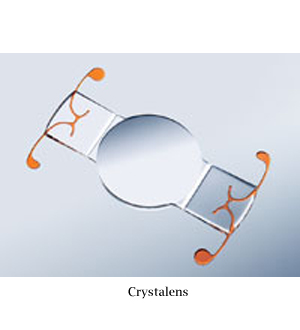Premium Multifocal Intraocular Lens Implants
Cataract surgery has undergone tremendous technological advances since the days of our grandparents and even our parents. Many patients can now choose to have both their vision and lifestyles improved, thanks to new advances in intraocular lenses and cataract surgery.
 Intraocular lens technology has taken a giant leap forward. No longer is the objective simply to improve distance vision. Today, the goal is to enhance vision with an intraocular lens that produces a full range of vision, minimizing dependence on reading glasses or bifocals.
Intraocular lens technology has taken a giant leap forward. No longer is the objective simply to improve distance vision. Today, the goal is to enhance vision with an intraocular lens that produces a full range of vision, minimizing dependence on reading glasses or bifocals.
A cataract is a clouding of the lens inside our eye. Mostly protein and water, the human lens can become clouded – so much so that it keeps light and images from reaching the retina. Eye injury, certain diseases or even some medications can cause clouding. But, in over 90% of cases, cataracts are caused by the aging process. Almost everyone will develop cataracts if they live long enough. Typically, people in their sixties and most people over seventy have some degree of cataracts.
Neither diet nor medication will make cataracts go away. If it has not matured to the point of interfering with our ability to safely perform our daily activities, we may just want to monitor the cataract’s progression with regular check-ups. The time to have cataracts removed is when the quality of vision begins to limit our activities and enjoyment of life.
Return to Top of Page
 Intraocular lenses were first introduced in 1949. Tremendous advances have occurred over time to the point where lens implants are routine in cataract surgeries. Until recently, when patients had cataract surgery a replacement lens could only focus at one point, usually at a predetermined distance. Although the quality of their vision was excellent, most patients still needed reading glasses or bifocals to see near objects. Today, premium multifocal lens implants are available, allowing patients to see clearly at all distances without bifocals or reading glasses.
Intraocular lenses were first introduced in 1949. Tremendous advances have occurred over time to the point where lens implants are routine in cataract surgeries. Until recently, when patients had cataract surgery a replacement lens could only focus at one point, usually at a predetermined distance. Although the quality of their vision was excellent, most patients still needed reading glasses or bifocals to see near objects. Today, premium multifocal lens implants are available, allowing patients to see clearly at all distances without bifocals or reading glasses.
In clinical studies, 80% of patients receiving these multifocal lens implants reported that they never needed to wear glasses following bilateral cataract surgeries. With these lenses, they can read a book, work on the computer, drive a car and play golf or tennis without glasses. In fact, patients were so pleased with their vision, nearly 90 to 95% of patients said they would have the multifocal lenses implanted again.
As with any surgical procedure, there are inherent risks and the results cannot be guaranteed. Some patients with multifocal lens implants see halos around lights, have less contrast sensitivity and report some difficulty with night driving.
Premium multifocal lenses currently available include ReSTOR, Crystalens, Rezoom and Tecnis. They each have different properties and functions. Based upon the individualized, visual needs of his cataract patients, Dr. Frederick Ho determines which multifocal lens is best. Dr. Ho has been using these premium multifocal lens implants since 2006. He will provide you with additional information on the benefits and risks associated with each lens to help you decide if cataract surgery and multifocal lenses are right for you.
Frequently Asked Questions
Return to Top of Page